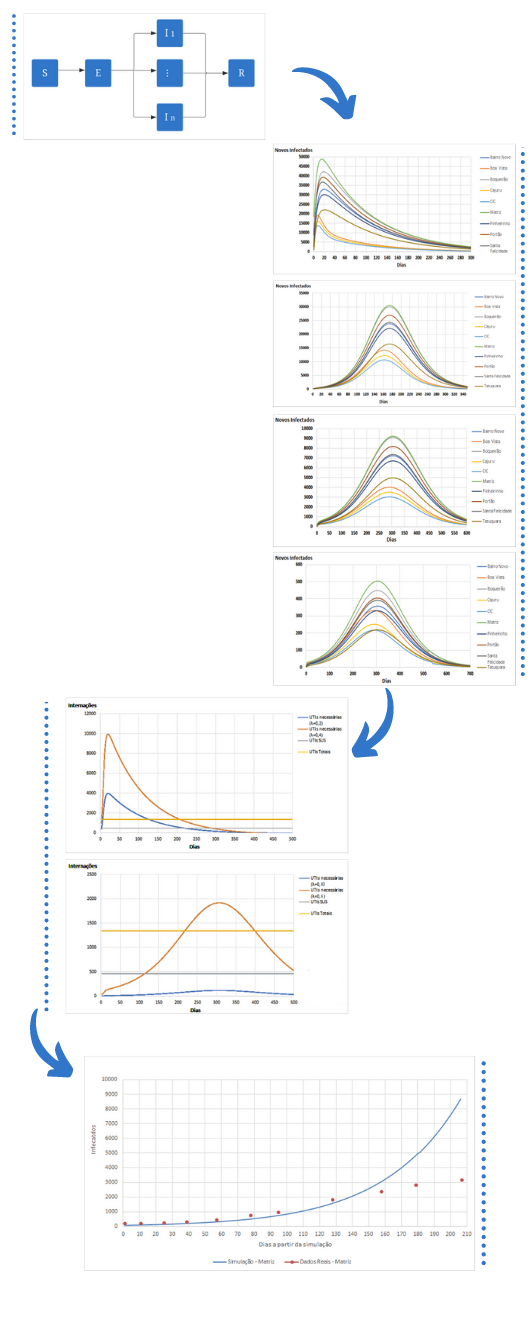SEIR Subregion Model Analysis: a case study of Curitiba
Keywords:
Covid-19, SEIR models, subregion models, hospital capacity, health system, epidemic modelsAbstract
The novel coronavirus SARS-CoV-2 was identified first in December of 2019, in Wuhan City, China. In a short period, thousands of infectious cases were reported in the world, and the hospital capacity was exceeded or saturated in some countries. For this reason, mathematical models were largely proposed to estimate the progression of Covid-19 pandemic and its impact on decisions to mitigate this progression. This paper proposes a modified “Susceptible Exposed Infectious Recovered” (SEIR) model to describe the behavior of the Covid-19 epidemic, based on characteristics of subregions. It was applied in data of the city of Curitiba, Brazil, and showed the best and worst scenarios to estimate the saturate and exceeded states on the health system.
Downloads
References
A. Derbali, and S. Hallara, “Measuring systemic risk of Greek banks: New approach by using the epidemic model “SEIR”,” Cogent Business & Management, vol. 3, no. 1, 2016.
A. Atkeson., "What Will be the Economic Impact of COVID-19 in the US? Rough Estimates of Disease Scenarios,” NBER, Cambridge, Massachusetts, USA, Tech. Rep. TR-26867, Mar., 2020.
C. Hou et al., “The effectiveness of quarantine of Wuhan city against the Corona Virus Disease 2019 (COVID‐19): A well‐mixed SEIR model analysis,” J. Med. Virol., pp. 1-8, 2020.
C. R. L. Francês et al., “COVID-19: Um novo modelo SEIR para países em desenvolvimento – estudo de caso para a Região Metropolitana de Belém,” Univ. Fed. do Pará., Belém, PA, BR, Tech. Rep., Abr. 2020.
Dados do Sistema Único de Saúde, Tabnet. Disponível em , acessado em 15 de maio de 2020.
F. Zhou et al., “Clinical course and risk factors for mortality of adult inpatients with COVID-19 in Wuhan, China: a retrospective cohort study,” Lancet, vol. 395, no. 1, pp. 1054-1062, 2020.
G. E. Weissman et al., “Locally Informed Simulation to Predict Hospital Capacity Needs During the COVID-19 Pandemic,” Annals of Internal Medicine, vol. 20, no. 1, 2020.
I. Abouelkheir et al., “A multi-regions SIS discrete influenza pandemic model with a travel-blocking vicinity optimal control approach on cells”, Am. J. Comput. Appl. Math, v. 7, n. 2, p. 37-45, 2017.
Instituto Brasileiro de Geografia e Estatística, Pesquisa Nacional por Amostra de Domicílios Contínua - PNAD Contínua. Disponível em:<https://www.ibge.gov.br/estatisticas/sociais/educacao/17270-pnadcontinua.html?edicao=24437&t=o-que-e>, Acesso em 08 de maio de 2020.
Instituto de Pesquisa e Planejamento Urbano de Curitiba - IPPUC, Nosso Bairro. Disponível em <https://ippuc.org.br/nossobairro/ >, acessado em 15 de maio de 2020.
J. S. Valdez et al., “Numerical Approaching of SIR Epidemic Model for Propagation of Computer Worms,” IEEE Latin America Transactions, vol.13, no.10, 2015.
Jornal Gazeta do Povo, Infográfico Covid-19: Curitiba Disponível em <https://especiais.gazetadopovo.com.br/coronavirus/curitiba/?utm_source=gazeta-do-povo&utm_medium=especiais&utm_campaign=coronavirus>, acessado em 04 de setembro de 2020.
K. Chouayakh et al., “A multi-regions SEIS discrete epidemic model with a travel-blocking vicinity optimal control approach on cells”, J. Math. Comput. Sci., v. 7, n. 3, p. 468-484, 2017.
K. Zhu and L. Ying, “Information Source Detection in the SIR Model: A Sample-Path-Based Approach,” IEEE/ACM Transactions on Networking, vol. 24, no.1, 2016.
Ministério da Saúde, Painel Coronavírus. Disponível em <https://covid.saude.gov.br/>, acessado em 15 de maio de 2020.
N. M. Ferguson, et al., "Impact of nonpharmaceutical interventions (NPIs) to reduce COVID-19 mortality and healthcare demand," Imperial College of London, London, UK, Tech. Rep. TR-009, Mar. 16, 2020.
O. Zakary, M. Rachik, and I. Elmouki, “On the analysis of a multi-regions discrete SIR epidemic model: an optimal control approach”, International Journal of Dynamics and Control, v. 5, n. 3, p. 917-930, 2017.
Organização Mundial de Saúde, Novel Coronavirus 2019. Disponível em <https://www.who.int/es/emergencies/diseases/novel-coronavirus-2019>, acessado em 15 de maio de 2020.
P.G.T Walker, et al., "The global impact of covid-19 and strategies for mitigation and suppression," Imperial College of London, London, UK, Tech. Rep. TR-012, Mar. 26, 2020.
W. O. Kermack and A. G. McKendrick, “A contribution to the mathematical theory of epidemics”, Proceedings of the Royal Society of London A: Mathematical, Physical and Engineering Sciences, vol. 115, no. 772, pp. 700-721, 1927.
Z. Yang et al., “Modified SEIR and AI prediction of the epidemics trend of COVID-19 in China under public health interventions,” J. Thorac. Dis., vol. 12, no. 3, pp. 165-174, 2020.


